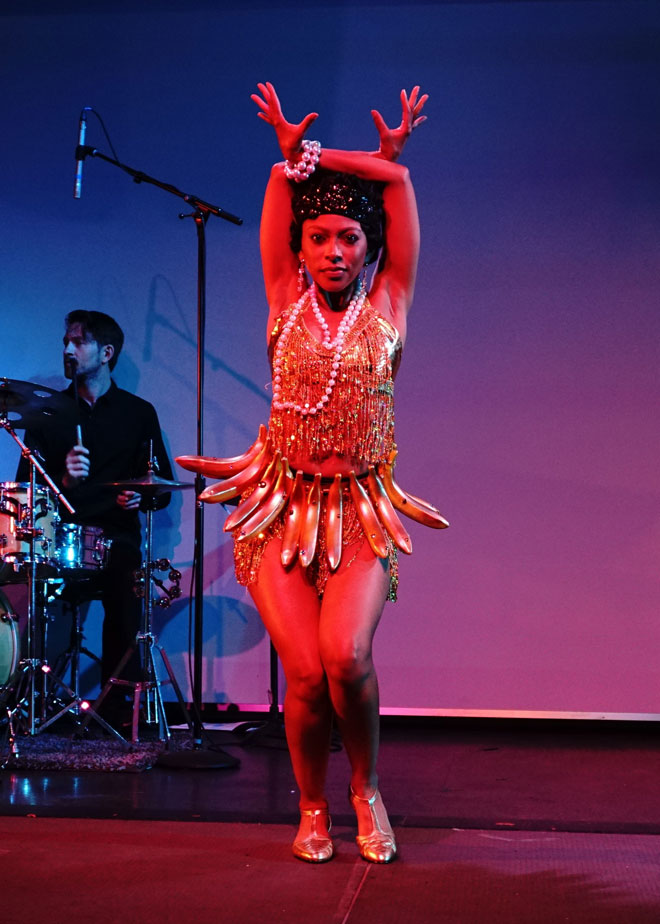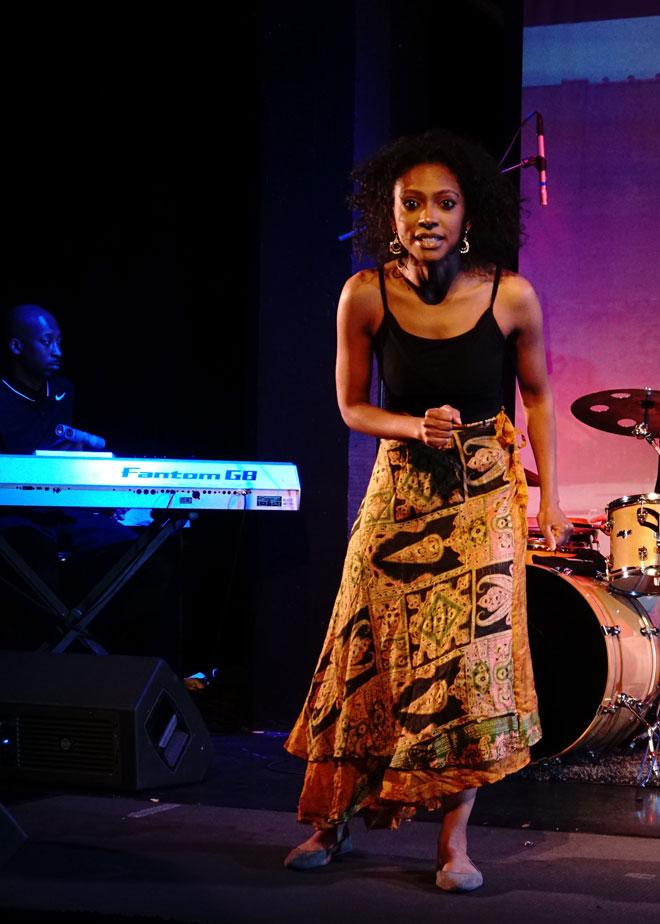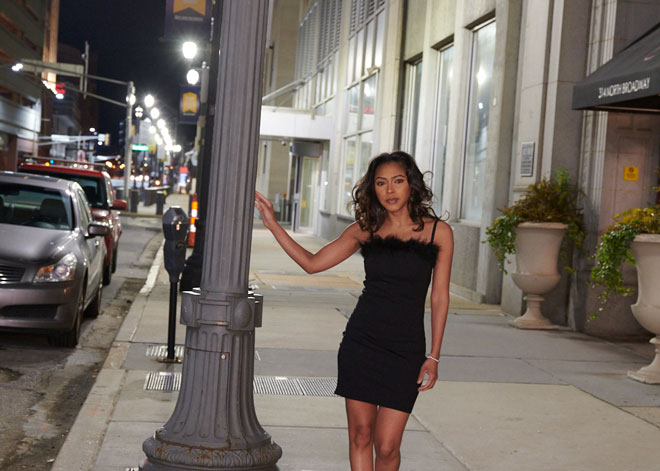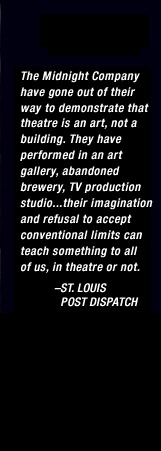A choreographer came on board and dance rehearsals ensued.
Designers were recruited, and the physical production began taking shape.
Musicians came aboard, and the live songs added an electricity to the process and the script.
LAKA's work continued to grow. She worked very hard on the dance, rehearsing at home with videos of rehearsal. And her ability as an actress grew and grew.
We moved into tech week, and everything came together fast.
We'd had the benefit of stunning PR. The title of the show, the subject, LAKA's photos (she doesn't take a bad one), and the outreach efforts of PR pro Elizabeth Donielle led to a plethora of TV, radio, blog and print appearances.
And all PR efforts were supported by Keyairis Henry's very cool video stylings.
And the crowds came. Lots of LAKA fans, and many others drawn by the nature, and then the word of mouth about the show. The final 5 performances were outrageous - we filled every seat in the .ZACK. The shows were impeccable, and the crowds, singing and clapping along the entire show, could scarcely wait till they could rise out of their seats and cheer LAKA and the production. The excitement in the theatre every night was palpable. As much as anything I loved the
crowd - a near 50/50 racial split, with all focused on the history of our city and the great
women who spent time here.

And the shows, as the writer/director, were all I hoped for and more. It seemed everyone was working at the top of their game:
Liz Henning, handling an acrobatic duo role as Costume Designer/Stage Manager, created a wide variety of beautiful costumes, including Josephine Baker’s banana skirt. And called a show with a daunting lineup of light/sound/projection cues.
Corey Patterson on piano and Gabe Bonfili on percussion were a tight and forceful presence.
Many friends commented on and complimented the array of great sounds they produced.
Michael Musgrave-Perkins video projections were a work of art. I’d told him I see St. Louis
as a dark city, urban and industrial. He captured that with images and film of the city through
the ages, and a design/color scheme and palette that beautifully backed up the action.
Tony Anselmo’s lights were always surprises, coating the stage with just right color and focus.
Our choreographer, Ashley Tate, offered sensational teaching. LAKA loved working with her,
while Ashley kind of had to take one for the team - while she’s capable and has offered many
major dance works through her company and other outlets, she had to restrict herself to
the short minutes of dance examples that we wanted for the show. She adjusted, and
perfected the shorter numbers we needed.
As he has for many Midnight shows, Kevin Bowman overshaw the technical elements of production.
And we were ably assisted by Board Op Mason Hegarty and dressers Journey Carter and
Khalil Shaw-Ensor during the shows, with pre-show contributions from Music Consultant Bruce Bramoweth and Audio Consultant Phillip Evans.

And then there was LAKA. This was her first play, her first eleven performances.
Every night she got better and better. Of course, I know the challenge of repeating a quality one-person show night after night. And she handled that impeccably.
Her acting, the characterizations of these different women, continued to grow. A remarkable aspect of it was that she seemed to embody not only the women, but the time, the era, when they lived. We went from 1900 St. Louis to the 20’s in Paris to the 50’s and 60’s in East St. Louis, and around the world. With LAKA’s intensity, we were there with Frankie and Johnny, and Josephine Baker and Tina, and all.
And the audience was right there with us.
Of course, her singing was spot on from the first music rehearsal. But it also got better and better. By the final performance, when she closed the show with Eartha Kitt’s arrangement of St. Louis Blues, I was hearing a voice I’d never heard before, as she got closer and closer
to her take on Kitt.
For me personally, besides audience reaction, great satisfaction came from a few specific numbers. Certainly, the arrival of Tina at the top of the second act was one, shocking the audience with rock ’n roll after a somewhat traditional if not sedate first act.
But in the numbers, the song, the costume, the lights and the video backgrounds came
together in truly magical ways.
There was Willie Mae Ford Smith's gospel medley. LAKA put on a white robe with cross,
the lights focused just on her with all else black except the projection of a church behind.
It was beautiful and uplifting, as LAKA went from an a cappella rendition, and then urging
“Church, put your hands together” as she segued into a rousing spiritual.
And then there was Josephine Baker's signature Jai'Deux Amours. With a background
graphic from Baker’s creole opera, LAKA (in French and in the most delicate 1930’s-soaked
voice) delivered a beautiful, classic ballad.
And one more - Tina Turner’s What’s Love Got To Do With It - not one of my favorite songs,
but I loved the way we did it - gorgeous unexpected lighting, highlighting a haunted
urban backdrop, with LAKA moving sensuously and singing that big hit even more
sensuously. Another staggering moment.

Overall, this show was an epic finish to Midnight’s 25th season. You can check out the
reviews below. I can say with all sincerity that the critics really missed this one. A couple
tried to dismiss it as cabaret. A couple were at full-house shows with roaring audiences.
But none of them realized the social phenomenon and the artistic statement that I believe
the show to be.
A unique history of our city, embraced by a knockout physical production, and led
by a breakout stage debut from a transcendent performer.
Good show.
PopLifeSTL.com
With Plenty Of Heart And Soul, ‘St Louis Woman’ Celebrates Trailblazers
by Lynn Venhaus
October 12, 2022
Love has got everything to do with it. The costumes are gorgeous, the musicianship splendid and the legendary subjects all deserving of the spotlight in the reverent play with music, “St. Louis Woman.” Local playwright Joe Hanrahan, Midnight Company’s founder and artistic director, has a deep knowledge and interest in local history as well as an affinity for and expertise in popular music.
In this enjoyable, affectionate showcase brimming with good beats and striking visuals, Hanrahan honors local legacies by presenting their impact on the world through an earnest young singer, Laka. Laka is a relative newcomer on the local music scene, having performed her first cabaret at the Blue Strawberry in April 2020, and she does not have any experience regional theater. This work is her stage debut – and it appears that her collaboration with Hanrahan took them both to their happy place. She is a likable performer, projecting perseverance and positivity, even if she is acting novice with more to learn.
Laka embodies their important traits of dedication and resolve as Hanrahan, also the director, unfolds snapshots of Josephine Baker, Tina Turner, Katherine Dunham, Maya Angelou, Fontella Bass, Ann Peebles, and Willie Mae Ford Smith. The women are all artists with some connection to St. Louis, whether they were born here, grew up here or moved her during their adult years. You might not have heard of everyone but by the end of the show, they will all be memorable.
Hanrahan reveals interesting tidbits about their lives while Laka tells their story in looks, voice and career/life observances. Each woman could be celebrated in their own show, but this ties them intrinsically together, in small-batch narratives. Hanrahan knows how to mine key details from his copious research to make the script flow. It’s well-constructed with moments big and small. “They brought this city to the world with their music, dance and poetry,” he said.
The accompanying music, with cool cats Corey Patterson on keyboards and Gabe Bonfili on percussion, had a fun vibe. They excelled at keeping the tempo upbeat and the mood pleasant – nice, easy and kicked up a notch. Bruce Bramoweth’s contributions as a music consultant helped set the piece, too.
Enhancing the show immeasurably is Liz Henning’s stunning costume designs – she captured each period and personality perfectly. The red-sequined mini-cocktail dress Laka rocked as Tina was a wow!
An accomplished video designer, Michael Musgrave-Perkins has done exceptional work with archival footage and vintage documents to convey time periods for each woman, setting us in a ‘you are there’ format. The selections are first-rate and the presentation polished.
Ashley L. Tate has executed appropriate choreography, particularly the iconic Banana Dance by Josephine Baker, and Tina Turner’s vivacious gyrations. Lighting Designer Tony Anselmo and Production Designer Kevin Bowman helped create the look that set the mood and the groove.
Straightforward and sincere, “St. Louis Woman” raises the voices of some remarkable women, leading lights once rolling on the river. It’s a remembrance to savor, a pride to share and world-class names forever linked to our city’s tapestry.
Broadway World
by James Lindhorst
October 7, 2022
The Midnight Company opened its world premiere production of ST. LOUIS WOMAN Thursday night at .Zack Theatre. ST. LOUIS WOMAN is a one-woman cabaret-style show starring Laka and is a celebration of phenomenal female talent who put St. Louis on the map with their music and art. Written by Joe Hanrahan, the musical review is a tribute to Josephine Baker, Tina Turner, Willie Mae Ford Smith, Katherine Dunham, Fontella Bass, Ann Peebles and Maya Angelou. Laka performs their music, dance and poetry while presenting their contributions to society as artists and activists.
Hanrahan's script provides a nostalgic look at St. Louis through the 1900s and the compelling lives of incredibly talented woman. His script is more than just a historic look at some famous St. Louis Women. It is an important lesson in St. Louis Black history, examining the lives of strong African American women who helped shape and improve this world for all women, especially women of color.
Laka's effective portrayal of more than a half-dozen real live artists is due to her ability to disappear into these women, allowing their spirit to inhabit her body. Her versatility allows her to span a century of music performing gospel, jazz, blues, R&B, and rock-and-roll. When she rips into the Music of Tina Turner, Fontella Bass and Ann Peebles at the beginning of the second act, her vocals blow the roof off the theater.
Michael Musgrave-Perkins' home movie-like video design compliments the nostalgic feel, invokes civic pride and places the audience in turn of the century St. Louis through 1960s St. Louis, 1920s Paris, and Europe during the Nazi invasion. Liz Henning's costume design is elegant, sumptuous, sparkling, and dazzling, spanning decades to enhance Laka's portrayal of these influential women.
ST. LOUIS WOMAN is more than a simple cabaret review. It is an essay of rich history that honors the contributions of women of color who all have one thing in common, St. Louis.
KDHX
The Midnight Company’s 'St. Louis Woman' Presents the Bright Lights from This Not-So-Big City
by CB Adams
October 9, 2022
The Guess Who gave us “American Woman.” The Doors gave us “L.A. Woman.” And now Joe Hanrahan and The Midnight Company bring it all back home with the world premiere of “St. Louis Woman,” a play with music starring local singer LAKA.
“St. Louis Woman,” written and directed by Joe Hanrahan, the company’s artistic director, is a well-intentioned one-woman show with the goal to present, as it’s billing states, “The City. The Songs. The Women.” To best describe “St. Louis Woman,” it’s best to define what it is. It may be an entertainingly educational story told – or more importantly, sung – about St. Louis’ legacy of successful women artists. Or it may be an educationally entertaining performance focused on a hundred-plus years of artistic boosterism. As LAKA exclaims early in the first half: “Booze. Broads. Bibles!”
This production is a nice reminder that St. Louis has incubated a fair share of iconic, history-making women, exemplified by LAKA’s portrayals of Josephine Baker, Willie Mae Ford Smith, Tina Turner, Katherine Dunham, Maya Angelou and Ann Peebles, among others. St. Louis is the portal through which these women are presented, but the city itself isn’t portrayed as the nurturing environment that its brightest stars might seem to indicate. These women were successful in spite of the sexism, racism, violence and abuse they experienced here – all of which aren’t exclusive to St. Louis, anyway.
This production is a nice reminder that St. Louis has incubated a fair share of iconic, history-making women, exemplified by LAKA’s portrayals of Josephine Baker, Willie Mae Ford Smith, Tina Turner, Katherine Dunham, Maya Angelou and Ann Peebles, among others. St. Louis is the portal through which these women are presented, but the city itself isn’t portrayed as the nurturing environment that its brightest stars might seem to indicate. These women were successful in spite of the sexism, racism, violence and abuse they experienced here – all of which aren’t exclusive to St. Louis, anyway.
This production is a nice reminder that St. Louis has incubated a fair share of iconic, history-making women, exemplified by LAKA’s portrayals of Josephine Baker, Willie Mae Ford Smith, Tina Turner, Katherine Dunham, Maya Angelou and Ann Peebles, among others. St. Louis is the portal through which these women are presented, but the city itself isn’t portrayed as the nurturing environment that its brightest stars might seem to indicate. These women were successful in spite of the sexism, racism, violence and abuse they experienced here – all of which aren’t exclusive to St. Louis, anyway.
“St. Louis Woman” is designed as an immersive experience that includes sound effects and a backdrop showing a constant stream of historic photographs and film clips that help illustrate LAKA’s songs and portrayals. These elements augment and enhance her performance – all thanks to video design by Michael Musgrave-Perkins, lighting design by Tony Anselmo and overall production design by Kevin Bowman.
All of this visual and aural stimuli provides an environment, an entertaining ecosystem, for LAKA’s portrayals of these divergently talented artists. Onstage, she is backed by her go-to musicians, Corey Patterson, who provides keyboards as well as music direction, and percussionist Gabe Bonfili. On opening night, this unassuming twosome was obviously comfortable backing LAKA. Patterson and Bonfili were often so effective it was almost easy to forget they were on stage – to their credit.
“St. Louis Woman” is an ambitious endeavor that strives to weave characters, history, personal asides, interesting factoids and Wikipedia-level research into a compelling narrative. It requires LAKA, in both first- and third-person narration as well through song, to pivot from character to character to character for almost two hours. That’s a tall order for even the most experienced actors, and one that obviously stretched LAKA’s acting (and sometimes dancing) skills to her limits. The costumes, which she changed into often and deftly, are one of the show’s strengths. Thanks to the design by Liz Henning, the costumes helped with the characterizations and provided the perfect visual clues. Henning’s take on Josephine Baker’s iconic banana skirt was spot on.
“St. Louis Woman” is an ambitious endeavor that strives to weave characters, history, personal asides, interesting factoids and Wikipedia-level research into a compelling narrative. It requires LAKA, in both first- and third-person narration as well through song, to pivot from character to character to character for almost two hours. That’s a tall order for even the most experienced actors, and one that obviously stretched LAKA’s acting (and sometimes dancing) skills to her limits. The costumes, which she changed into often and deftly, are one of the show’s strengths. Thanks to the design by Liz Henning, the costumes helped with the characterizations and provided the perfect visual clues. Henning’s take on Josephine Baker’s iconic banana skirt was spot on.
I was hopeful that LAKA could achieve the same type of engaging, in-the-moment characters that Whoopi Goldberg conjured in her one-woman show from the early 80s, “The Spook Show.” Although LAKA’s acting grasp falls somewhat short of this show’s intricate script, it is her singing that saves the show from its expository, middle-school field trippiness. LAKA was fully on top of the entire range of songs she performed. And an impressive range it was, including “Jai' Deux Amours,” “The Times They Are A' Changin’,” “Nutbush City Limits,” “Proud Mary,” “Rescue Me” and, of course, “St. Louis Blues.”
Opening night on Thursday, Oct. 7 had the usual opening-night glitches, including flubbed lines, hard-to-hear dialogue, mic issues and miscues, but, hey, that’s why we love live theater. All can be forgiven.
By the conclusion of “St. Louis Woman,” I wondered whether this city was all that important to the ultimate success of Willie Mae, Maya and Katherine, et al. It’s like one of Ann Peebles’ albums covers, stating she was a St. Louis woman, but with a Memphis soul. There isn’t really a St. Louis sound – at least not like the distinctive styles associated with Detroit, Baltimore or Memphis.
This show’s icons may have reached stardom – oftentimes international stardom – regardless of the St. Louis association. All found their fame outside of our city limits. It’s no one’s fault that St. Louis women (at least the ones presented in this show) find their souls lie elsewhere. And maybe that’s the unintended message in “St. Louis Woman.” Rather than “George Washington slept here,” we get “Ike hurt Tina here.” The good news is that we still got Tina, and the rest of the St. Louis women, anyway.
This is that kind of show. Come for the songs. Stay for the songs. And if along the way you learn a thing or two about St. Louis and the exceptional women it has helped form, then it’s a good thing – and well worth the price of admittance.

Two On The Aisle
The Midnight Company’s 'St. Louis Woman' Presents the Bright Lights from This Not-So-Big City
by Bob Wilcox
October, 2022
Joe Hanrahan writes and produces and performs some of the best plays around here. Not only is it good writing, it’s good theatre, and it’s good material, with its own twist on something that might start out looking familiar.
But his Midnight Company’s current production is not so much a play as it is a cabaret performance. He calls it St. Louis Woman, and that’s what it is, song and stories by and about St. Louis women. He researched the familiar and the less familiar about them to form the informative material about the women and their songs. They are told and sung by LAKA, a terrific young singer, storyteller and dancer. Hanrahan directed it. Music director and keyboard player Corey Patterson and percussionist Gabe Bonfili accompany the songs and sometimes the stories. Choreographer Ashley L. Tate guided LAKA through the changing dance styles of the twentieth century. Michael Musgrave-Perkins’ video design moves scenes of St. Louis through the years with iconographic images of the women and their colleagues. Liz Henning’s costumes we recognize for each of the women. Tony Anselmo designed lighting, Kevin Bowman designed the production, Philip Evans consulted on the audio and Bruce Bramoweth on the music.
Our chronological journey with St. Louis women begins with the twentieth century and Frankie Baker, the Frankie of Frankie and Johnny and the song that told the world about a St. Louis woman. Frankie was soon followed by W.C. Handy’s St. Louis woman, who gives her rivals the St. Louis blues, stealing their man. Next LAKA becomes a singer who was quite different from those two. Willie Mae Ford Smith became the most influential Gospel singer in the country and made St. Louis the home of Gospel music.
LAKA spends some time with Freda Josephine McDonald, from Frankie and Johnny’s neighborhood, known to the world as Josephine Baker, star of Paris’s nightclubs and theatres, hero of France’s World War II Resistance and of the American Civil Rights Movement.
After intermission it’s time for rock ’n’ roll and Tina Turner, Fontella Bass, and Ann Peebles. And a dancer, Katherine Dunham, born in Chicago, student of the dances of the Caribbean Islands, innovator of American dance, famed teacher in Edwardsville and East St. Louis. And another civil rights activist, and dancer, and actor, and especially a writer, native St. Louisan Maya Angelou.
Joe Hanrahan’s script challenged LAKA with each and all of these St. Louis women. She met the challenges with style and grace, and with an admiration and respect for each of them that she shared with each of us, to our great pleasure in a richly satisfying evening.
Ladue News
Laka and The Midnight Company showcase artistic women who brought fame to St. Louis
by Mark Bretz
October 17, 2022
Highlights: Yalaka “Laka” Huyette is an accomplished vocalist with a background in gospel choirs and cabaret performances. The latter suit her especially well in this two-act world premiere, in which Hanrahan offers capsule biographies of seven well-known Black female performers of the 20th century – two of whom, Peebles and Turner, are still surviving today.
Story: Performer Laka and playwright Joe Hanrahan bring attention to seven women who helped put St. Louis on the map with their music and other artistic skills. Hanrahan and Laka provide information and artistic examples of seven Black women – Josephine Baker, Willie Mae Ford Smith, Katherine Dunham, Maya Angelou, Tina Turner, Fontella Bass and Ann Peebles – whose music, dance, writing and other artistic output brought a greater appreciation to the Gateway City and its environs.
Other Info: Aided by the invaluable contributions of video designer Michael Musgrave Perkins, the show uses background visuals consisting of old photographs and other things to set the stage for this diverse collection of talented individuals. Costume designer Liz Henning outfits Laka in a stunning sequence of fashionable selections that reflect the specific artistic stylings of each member of the septet in recognizable fashion, whether the Roaring ’20s wardrobe favored by Baker or the tight miniskirts gracing Turner.
Laka brings an agreeable persona to her portrayals of these musical and artistic pioneers in a cabaret style in which she is doubtless familiar to many folks, adding selected dance moves created by choreographer Ashley Tate. She is also backed up with the considerable musical abilities of keyboardist Corey Patterson and percussionist Gabe Bonfili. Patterson also ably serves as musical director, and Bruce Bramoweth is musical consultant for the sundry selections used in the show.
Tony Anselmo’s incisive lighting design accentuates Laka’s appealing portrayals, and Kevin Bowman’s production design supplements the intimate look of the presentation.
In addition to various song stylings, Laka takes time to honor Angelou by reciting some of the latter’s poetry and demonstrates certain of Dunham’s famous dance moves, which were an integral part of the latter’s studio in East St. Louis for many decades.
From the soulful gospel intonations of Smith to Baker’s slick and risqué nightclub act to the rock ’n’ roll of the gyrating Turner and the rhythm and blues of Bass and Peebles, “St. Louis Woman” serves as a satisfying introduction to the artistic skills of these seven artists.
Hopefully, Laka’s energetic performance and Hanrahan’s basic script will inspire appreciative patrons to learn more about these distaff pioneers and the positive attention they brought and, in the case of Peebles and Turner, are still bringing to our area through their considerable work and talent.
Snoops Theatre Thoughts
by By Michelle Kenyon
October, 2022
The Midnight Company’s latest production, St. Louis Woman, is more of a revue than a play. Written by the company’s artistic director Joe Hanrahan, the show features a dynamic central performance by a talented singer backed by first-rate musicians, and features an illuminating backdrop of projections that illustrate the stories well. The show tells the stories of St. Louis women in music and the arts, with a variety of songs, dancing, and informative narration.
St. Louis Woman is a one-woman show starring locally-based singer/songwriter and cabaret performer LAKA, who narrates the history of women–particularly Black women–in the arts in St. Louis from the late 19th Century until the present day. She starts out telling the stories behind the classic songs “Frankie and Johnny” and W.C. Handy’s “St. Louis Blues”, singing the songs with style and power. Then, the story turns to individual performers and a variety of musical styles, from Willie Mae Ford Smith’s gospel music to the soul and R&B sounds of Fontella Bass and Ann Peebles. There are also sections about dancer and choreographer Katherine Dunham and writer Maya Angelou. The biggest featured segments, however, are those centered around legendary singer and cabaret performer Josephine Baker, and Rock/Pop/R&B icon Tina Turner. The performance is a lesson in history as well as a celebration of the work of these celebrated artists, introduced and performed with memorable and versatile style by LAKA.
The main reason to see this production is undoubtedly its leading performer, as well as the superb backing musicians, music director Corey Patterson on keyboards and Gabe Bonfili on percussion. LAKA is notable for her remarkable versatility as she manages various styles from Jazz, to pop, to gospel, to R&B, to rock n’ roll, with excellent power and presence, managing to sing in the styles of the performers she portrays with expert skill, in marvelous tribute to these legendary performers. Acting-wise, she seems a little more uneasy at times, although she also has moments of excellence, especially in the Tina Turner sequence.
The show itself is highly informative and fascinating, for the most part, although some of the segments are dragged out a little too much, and sometimes it seems more like a series of disjointed vignettes than a cohesive show. The transitions (in which LAKA changes costumes) can be overly long as well, although the musicians and Michael Musgrave-Perkins’s eye-catching projections do help maintain interest in these moments. Visually, it’s an enjoyable show in terms of those wonderful projections of historical photos, and the detailed costumes by Liz Henning, along with Tony Anselmo’s evocative lighting.
Overall, I would say that St. Louis Woman is an entertaining and informative production, covering the important St. Louis music and art and the women who made an impact on this city, and on the world. Although there are a few rough edges, it’s still a memorable, well-performed production featuring an immensely talented performer. LAKA gives this performance her all, and her voice, versatility, and enthusiasm are great reasons to see this show.



